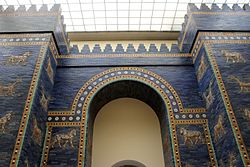
Back تاريخ العراق Arabic Historia d'Iraq AST İraq tarixi Azerbaijani Ираҡ тарихы Bashkir ইরাকের ইতিহাস Bengali/Bangla Història de l'Iraq Catalan مێژووی عێراق CKB Dějiny Iráku Czech Hanes Irac Welsh Iraks historie Danish
| History of Iraq |
|---|
 |
|
|
Iraq is a country in West Asia that largely corresponds with the territory of ancient Mesopotamia. The history of Mesopotamia extends from the Lower Paleolithic period until the establishment of the Caliphate in the late 7th century AD, after which the region came to be known as Iraq. Encompassed within Iraqi territory is the ancient land of Sumer, which came into being between 6000 and 5000 BC during the Neolithic Ubaid period of Mesopotamian history, and is widely considered the oldest civilization in recorded history. It is also the historic center of the Akkadian, Neo-Sumerian, Babylonian, Neo-Assyrian, and Neo-Babylonian empires, a succession of local ruling dynasties that reigned over Mesopotamia and various other regions of the Ancient Near East during the Bronze and Iron Ages.[1]
Iraq during antiquity witnessed some of the world's earliest writing, literature, sciences, mathematics, laws and philosophies; hence its common epithet, the Cradle of Civilization.
This era of self-rule lasted until 539 BC, when the Neo-Babylonian Empire was conquered by the neighbouring Achaemenid Empire under Cyrus the Great, who proclaimed himself "King of Babylon". The ancient city of the same name, which had been the titular center of both Babylonian civilizations, became the most important of the four Achaemenid capitals.
Over the next 700 years, the regions forming modern Iraq came under Greek, Parthian, and Roman rule, with the Greeks and Parthians establishing new imperial capitals in the area with the cities of Seleucia and Ctesiphon, respectively. By the 3rd century AD, when the area once again fell under Persian (Sasanian) control, nomadic Arab tribesmen originating from South Arabia (consisting mostly of modern-day Yemen) began to migrate and settle within Lower Mesopotamia, culminating in the creation of the Sassanid-aligned Lakhmid Kingdom in around 300 AD; the Arabic name al-ʿIrāq dates to roughly this time.[2] The Sassanid Empire was eventually conquered by the Rashidun Caliphate in the 7th century, with Iraq specifically falling under Islamic rule following the Battle of al-Qadisiyyah in 636.[3] The city of Kufa was founded shortly thereafter, in close proximity to the previous Lakhmid capital of Al-Hirah, and it became the home of the Rashidun dynasty from 656 until their overthrow by the Umayyads in 661. With the rise of the Abbasids in 750, Iraq once again became the center of Caliphate rule—first in Kufa from 750–752, then in Anbar for the following decade, and finally in the city of Baghdad after its founding in 762. Baghdad would remain the capital of the Abbasid Caliphate for the majority of its existence, during which time it became the cultural and intellectual center of the world in what is known today as the Islamic Golden Age. Baghdad's rapid growth and prosperity in the 9th century would be followed by a period of stagnation in the 10th century due to the Buwayhid and Seljuq invasions, but it remained of central importance until the Mongol invasion of 1258. After this, Iraq became a province of the Turco-Mongol Ilkhanate and declined in importance. After the disintegration of the Ilkhanate, Iraq was ruled by the Jalairids and Kara Koyunlu until its eventual absorption into the Ottoman Empire in the 16th century, intermittently falling under Iranian Safavid and Mamluk control.
Ottoman rule ended with World War I, after which the British Empire administered Mandatory Iraq alongside a nominally self-governing Hashemite monarchy headed by King Faisal I. The Kingdom of Iraq was eventually granted full independence in 1932 under the terms of the Anglo-Iraqi Treaty, signed by High Commissioner Francis Humphrys and Iraqi Prime Minister Nuri al-Said two years prior. A republic formed in 1958 following a coup d'état. Saddam Hussein governed from 1968 to 2003, into which period fall the Iran–Iraq War and the Gulf War. Saddam Hussein was deposed following the 2003 U.S. invasion of Iraq.
- ^ "Baghdad's Treasure: Lost To The Ages", Time, 28 April 2003, archived from the original on March 7, 2008, retrieved 4 May 2010
- ^ Ramirez-Faria, Carlos (2007). Concise Encyclopedia Of World History. Atlantic Publishers & Dist. p. 33. ISBN 9788126907755.
{{cite book}}:|work=ignored (help) - ^ D. Gershon Lewental, "QĀDESIYA, BATTLE OF," Encyclopædia Iranica Online, available at http://www.iranicaonline.org/articles/qadesiya-battle Archived 2020-10-04 at the Wayback Machine (accessed on 21 July 2014).
© MMXXIII Rich X Search. We shall prevail. All rights reserved. Rich X Search